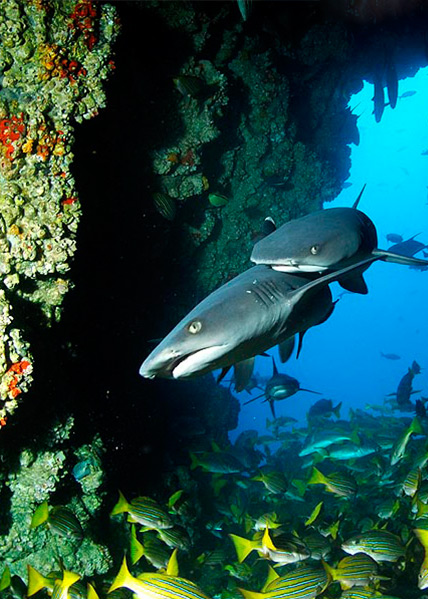Cocos Island

Coral Reefs
Importance and threats
Coral reefs are one of the most valuable and biologically diverse ecosystems on Earth. One of the reasons why coral reefs are so valuable is because they function as centers of marine life activity. It is estimated that 25% of all marine life, which includes more than 4,000 species of fish, depends on coral reefs at some point in their life cycle. Approximately 500 million people around the world depend on coral reef ecosystems for food, coastal protection, and income from tourism and fishing.
The reefs at Cocos Island National Park have undergone bleaching phenomena that have produced great mortality, many of them associated with El Niño. For example, El Niño from 1982 to 1983 produced one of the largest coral mortalities, leaving only 3.5% alive. However, data show a high recovery in coverage after bleaching events, which currently continue to be one of the main threats given the increase in the average sea temperature and the increase in the frequency of natural events such as El Niño.
Corals of the Cocos Island National Park
Cocos Island has one of the most diverse coral reefs in Costa Rica. The fish community of Cocos Island National Park is represented by a large number of carnivorous species, followed by top predators, herbivores, and planctivores. In general, reefs at CINP are healthy, with complex and functional trophic chains, where species of high commercial value are in good condition. The effectiveness of conservation and management activities in Cocos Island can be seen in the recovery and complexity of the reef community. In total, 17 species of corals have been reported (See list). It is the location with the highest number of species in Costa Rica, and some species have only been reported on the island (Pavona xarifae and Leptoseris scabra).
Many of the endemic species of the island have been found in coral reefs. In addition, the coral and rocky reefs of the island have one of the largest fish biomasses found in the Eastern Tropical Pacific Ocean, which places CINP as one of the most important marine conservation sites in the region, especially for those species with high fishing pressure. In these reefs, there is a great abundance of top predators, such as sharks, representing very good health in these ecosystems, keeping the trophic webs in balance. The reefs represent sites where large pelagic species can go to forage, clean themselves, or rest, which substantiates the importance of keeping these ecosystems healthy.
Cocos Island is of great importance for the Eastern Pacific Ocean, since it has been considered as the cornerstone of larvae connectivity between both ends of the Pacific Ocean, due to its location and the influence it receives from ocean currents.
Research
These reefs have been widely studied since the 1980s; however, research has focused on coral reef cover (e.g. Guzmán & Cortés 1992; Cortés & Guzman 1998). The results obtained by Alvarado et al. (2015) detail the composition of fish and invertebrates, as well as the complexity of the reef. The sea urchin, Diadema mexicanum, was the only predominant species. The density of the Panulirus lobsters stands out as the highest in the Eastern Tropical Pacific Ocean, as well as the sea cucumber, Isostichopus fuscus, which has a high commercial value. When comparing the works carried out from 1987 to this day, the recovery in the live coral cover through time is evident, mainly due to: 1) a decrease in the pressure of the bioerosive action of the sea urchin, D. mexicanum; and 2) conservation measures that have been imposed on the island. This has favored reefs to be complex and rugged.

